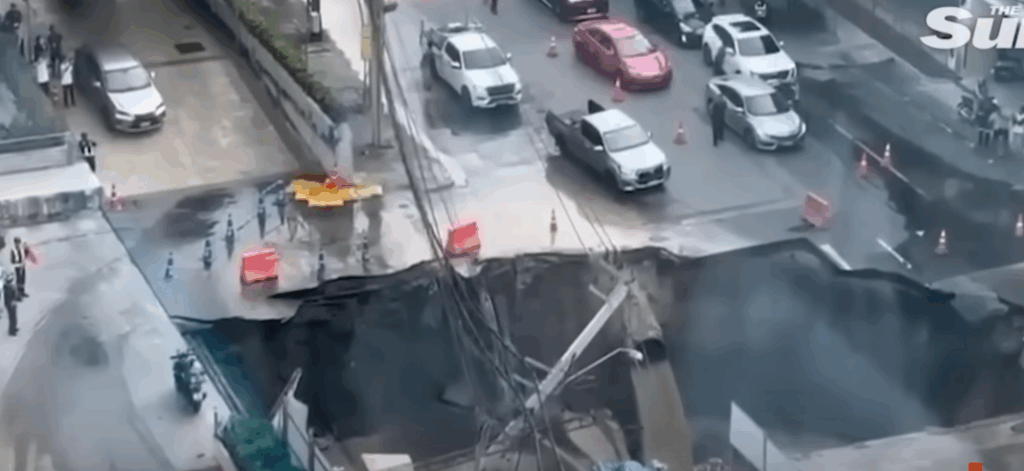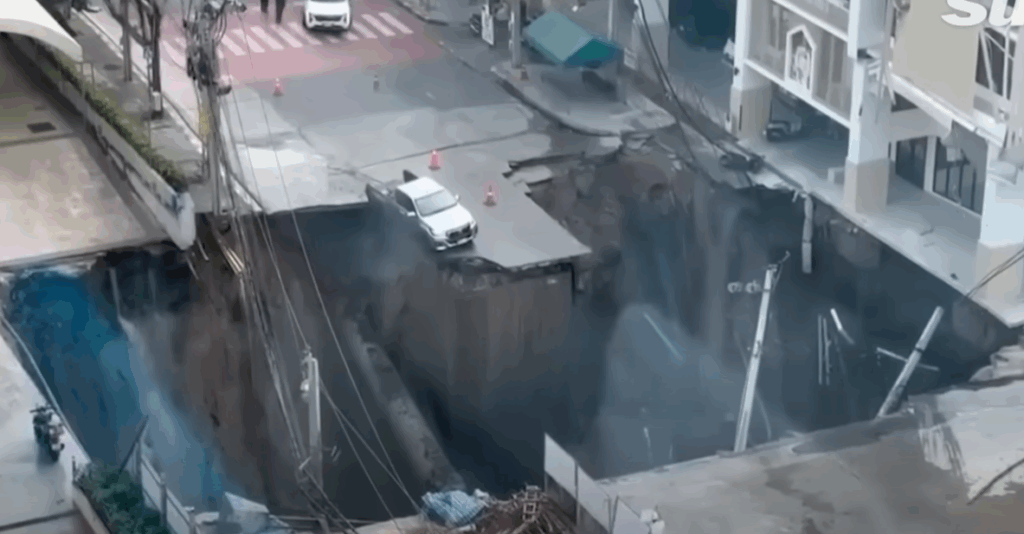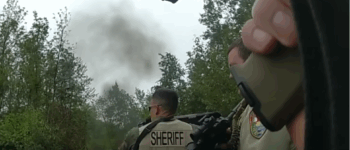Bangkok, Thailand – Residents and commuters in the Thai capital were left stunned when a gigantic sinkhole suddenly opened up outside a hospital on the outskirts of Bangkok, swallowing an entire section of road and sending shockwaves of fear across the community. The terrifying incident, captured in real-time by passersby, unfolded amid days of relentless rainfall and flooding that have crippled much of the country.
The dramatic footage shows the asphalt splitting apart, chunks of concrete tumbling into the void, and torrents of muddy floodwater pouring down into the sinkhole as onlookers screamed in disbelief. Power poles tilted dangerously, raising fears of electrical fires and mass blackouts, while vehicles swerved and reversed frantically to avoid being consumed.

Panic and chaos at the scene
Eyewitnesses described the collapse as “apocalyptic,” with many initially thinking an earthquake had struck. Within seconds, the ground gave way, dragging soil, pipes, and debris into a cavernous pit that seemed to expand by the minute.
One woman’s voice, trembling with fear, was heard in a livestream shouting in Thai:
“โอ้ยตายแล้ว! ต่อหน้าต่อตาเลย!” (“Oh God, right in front of my eyes!”)
Another man shouted frantically:
“The road has sunk! Pull back the cars before they fall in!”
Motorists on the affected stretch of road barely escaped disaster. Cars were seen reversing at high speed, while pedestrians sprinted away from the collapsing asphalt. Bystanders clapped in relief when an ambulance managed to pull away just before the road crumbled beneath it.
Amid the chaos, local residents shouted warnings about falling power poles. “ไฟระเบิด! (The electricity will explode!)” someone screamed as sparks flickered from cables crashing into floodwater.
Hospital and emergency response
The sinkhole appeared directly in front of a district hospital, triggering fears that emergency services could be cut off. Medical staff were seen rushing to secure entrances and move vulnerable patients to safer wings of the building.
Police and rescue teams arrived within minutes, setting up barricades and rerouting traffic. Ambulances were redirected to alternative routes, while engineers inspected the hospital’s foundation to ensure it remained stable.
A police officer at the scene told reporters:
“The priority was to keep the hospital safe and prevent cars from falling in. Thankfully, no one was killed, but the risk remains extremely high.”

Why did the road collapse?
Authorities have linked the disaster to the collapse of a flood barrier along the Pa Sak River. Once the barrier failed, massive volumes of water surged into surrounding neighborhoods, eroding the ground beneath the already fragile road.
Geologists explained that Bangkok’s clay-heavy soil, combined with poor drainage and the weight of standing water, can quickly destabilize asphalt foundations. After several consecutive days of intense rain, the roadbed simply caved in.
Professor Anan Kittisak, a civil engineering expert, noted:
“This is a textbook case of soil liquefaction combined with hydrological pressure. Once the flood barrier failed, the water undermined the ground until the road had no support left. We may see more of these sinkholes if the rain continues.”
The wider crisis
The sinkhole is only one symptom of a much broader crisis. Several provinces across central Thailand are struggling with severe flooding, with thousands of families displaced and farmland inundated. Roads, bridges, and public infrastructure are under immense strain.
In Bangkok, the collapse has worsened traffic chaos. Key routes into the city have been cut off, forcing drivers to make lengthy detours. Public buses have suspended service in several neighborhoods, while shops and businesses near the hospital remain closed.
Local residents expressed both fear and frustration.
“We feel abandoned,” said Somchai, a shopkeeper whose business was destroyed by the collapse. “Every year the government promises better flood control, but every year it’s the same story. This time, the road itself has disappeared.”
Government and rescue efforts
Bangkok’s governor has declared the area an emergency zone and ordered engineers to conduct urgent inspections of other flood-prone roads. The Metropolitan Electricity Authority confirmed localized blackouts but assured the public that repair teams were working “around the clock” to restore power.
The government has also promised temporary housing and compensation for affected families. Relief teams are distributing food, clean water, and medical supplies in flooded areas, while military units have been deployed to assist with evacuations.
Still, questions remain about Thailand’s preparedness for extreme weather. Critics argue that poor urban planning, outdated drainage systems, and insufficient investment in flood defenses have made disasters like this inevitable.
What’s next?
Meteorologists warn that more heavy rain is expected in the coming days, which could worsen the flooding crisis and create further risk of road collapses. Authorities are urging residents to avoid unnecessary travel, especially near rivers, canals, and hospitals located in low-lying districts.
As night fell, the sinkhole remained an ominous reminder of nature’s power and human vulnerability. The once-busy road, now reduced to rubble and water-filled craters, has become a symbol of the fragile balance between Bangkok’s sprawling urban growth and the forces of climate change.


